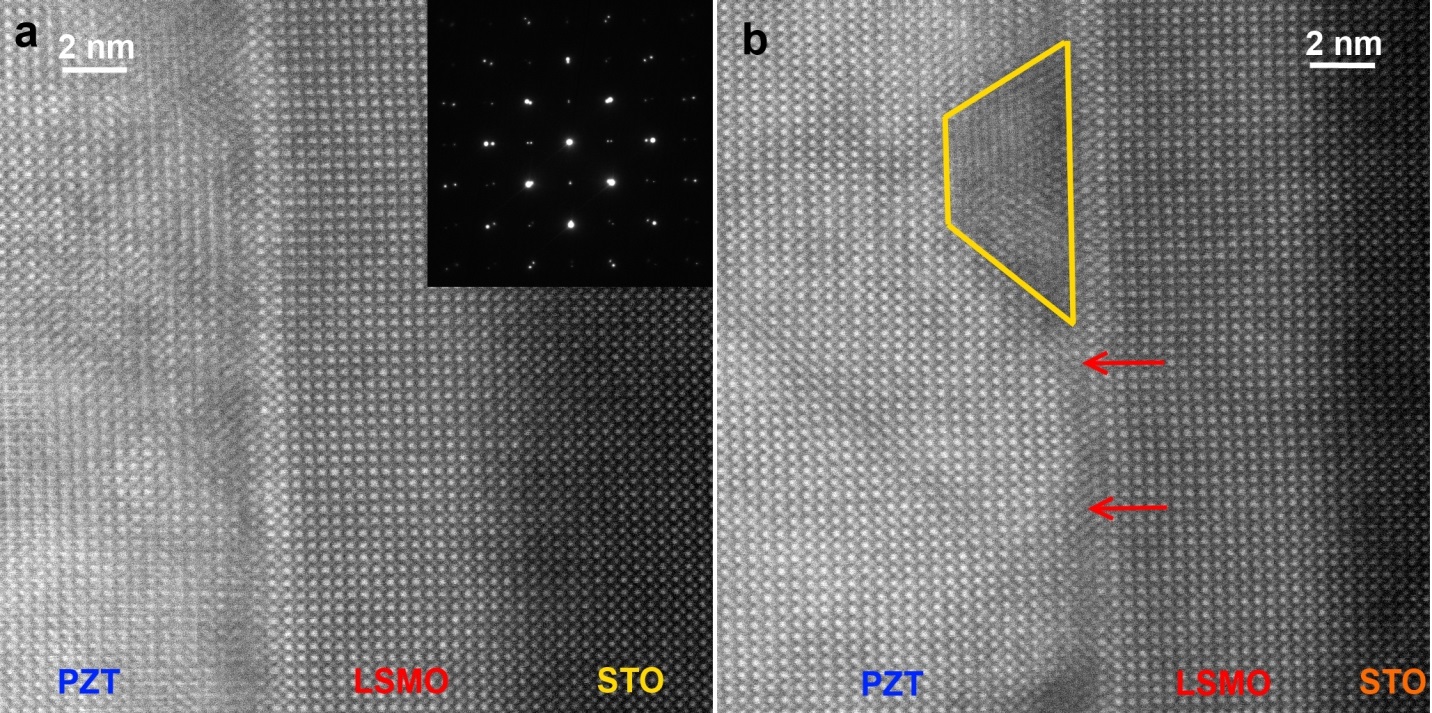Multiferroic Thin Films
Due to its unique properties – being a strongly correlated half-metal ferromagnet with a Curie temperature (TC) around room temperature – thin and ultra-thin epitaxial films of La1-xSrxMnO3 (LSMO) have been demonstrated to be a good candidate for multiferroic heterostructures when combined with ferroelectric substrates or ferroelectric thin films. An essential prerequisite for reliability of such multilayer systems is a good quality of the respective interfaces as the investigated effects, be it charge injection or strain effects, are interfacial phenomena.
Large-distance magnetron sputtering is a competitive alternative to other well-established PVD methods. In collaboration with Robert Kruk’s group, we have characterized the multiferroic thin films deposited in a custom made sputtering chamber from Createc Fischer GmbH. Transmission electron microscopy (TEM) and selected area electron diffraction (SAED) was performed on crosssections of representative samples to study their crystal structure and the interface between substrate and film. The chemical composition was analysed by energy dispersive X-ray spectroscopy (EDX) on TEM cross-sections.
1. Structure of La0.75Sr0.25MnO3 thin films sputtered on SrTiO3
TEM investigations confirm the excellent epitaxial growth of LSMO on STO, as can be seen in the Fig. 1.1. The dc-sputtered LSMO films grow perfectly cube-on-cube with identical lateral lattice constants. In the SAED pattern taken from the interface region including equal STO and LSMO areas, no distinguishable discrepancy was observed from film and substrate. The EDX and EELS spectra profiles confirm the good homogeneity of the elemental distribution in the film.

Fig. 1.1 HRTEM, STEM and SAED images of dc-sputtered LSMO on STO

Fig. 1.2 STEM/EDX-EELS spectra profiles
2. Structures of epitaxial LSMO/PZT heterostructures
A 6.5 nm thick LSMO layer can be grown epitaxially on the STO substrate without defects at the interface. At the interface between LSMO and PZT, there are 2-3 PZT unit cells with a laterally compressed lattice epitaxially deposited on LSMO (Figure 2.1a). On top of this thin layer, different types of defects were observed to relax the lattice strain in the PZT layer. The defects include extended edge dislocation and highly disordered domains (Figure 2.1b), which lead to the large leakage current. The crystallinity is believed to be highly related tothe ferroelectric property of the material.

Fig 2.1 HAAD STEM images of a) 6.5 nm LSMO coherently deposited on STO substrate without defect at the interface. Two atomic layers of PZT were found coherently grown on LSMO; b) highly disordered domain in PZT layer and an extended dislocation on the PZT/LSMO interface.
Details to this work have been published at
- P.M. Leufke, A.K. Mishra, A. Beck, D. Wang, C. Kübel, R. Kruk, "H. Hahn, Large-distance rf- and dc-sputtering of epitaxial La1−xSrxMnO3 thin films", Thin Solid Films. 520 (2012) 5521–5527.
- P.M. Leufke, R. Kruk, D. Wang, C. Kübel, H. Hahn, "Ferroelectric vs. structural properties of large-distance sputtered epitaxial LSMO/PZT heterostructures", AIP Advances. 2 (2012) 032184.

